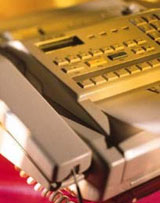|
 Most people might think that the fax machine, found in many offices and homes, is a relatively new piece of technology. In fact, a patent for the fax machine was issued in 1843, 33 years before the telephone! A Scottish clockmaker, Alexander Bain, invented this device in the same year that the first telegraph message was being sent across America. Most people might think that the fax machine, found in many offices and homes, is a relatively new piece of technology. In fact, a patent for the fax machine was issued in 1843, 33 years before the telephone! A Scottish clockmaker, Alexander Bain, invented this device in the same year that the first telegraph message was being sent across America.
Although Bain worked out the method, he never actually sent a fax transmission. It was not until 1865 that the first working fax machines and transmission service were set up. An Italian
Abbotnamed Giovanni Caselli developed the "
pantelegraph" which was used to send pictures and writing between French cities.
The way that a fax machine works is quite straightforward. A
sensorscans horizontally across the sheet one line at a time - like your eyes when you're reading a book. If the sensor sees a white patch it records a 0, and if it sees a dark patch it records a 1. In this way the whole page is "digitised" into a string of 0s and 1s. A
modemturns this into a series of high or low pitched sounds that are sent down the phone line to a remote
receiver. At the other end, the sounds are turned back into 0s and 1s. These are printed onto a piece of paper as light or dark dots, and so the original picture is reproduced hundreds of miles away.
For the very first fax machines, the pictures had to be printed onto
tin foilwith non-conducting ink. An
electrodescanned across the surface and sensed a light or dark patch depending on the current that flowed. The transmitting and receiving machines had drums that spun at the same speed, and every revolution clicked 0.5mm to the left so that eventually the whole picture was scanned. These machines took about half an hour to send a 20cm x 15cm photograph.
But faxes didn't really take off until the 20th century. In 1902 Dr Arthur Korn developed a fax machine with an
optical scannerthat allowed plain paper images to be sent. This is basically the same design used today, with the received image being printed on
heat-sensitive paper. Nowadays a photojournalist can send a
high-resolution pictureto his newspaper headquarters in less than a minute.
|
